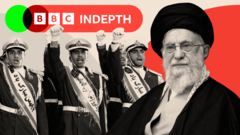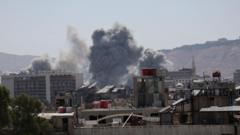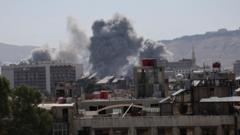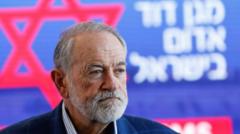The war with Israel has left Iran in disarray, with many citizens blaming Supreme Leader Ayatollah Ali Khamenei for the devastation. As he contemplates re-emerging, the internal rifts and dissatisfaction among the populace suggest that a new era may be dawning in Iran, marked by potential regime instability.
Iran's Supreme Leader Faces a Changed Nation Post-War with Israel

Iran's Supreme Leader Faces a Changed Nation Post-War with Israel
Ayatollah Ali Khamenei, after nearly two weeks in hiding, prepares to confront a transformed Iran amid widespread dissent and military degradation.
After more than two weeks spent in hiding from potential assassination amid an ongoing conflict with Israel, Iran's Supreme Leader, Ayatollah Ali Khamenei, may finally consider resurfacing. The octogenarian clergyman has remained secluded, reportedly for his safety, while most government officials have been out of contact with him. Despite the fragile ceasefire brokered by U.S. President Donald Trump and the Emir of Qatar, there are ominous signs for Khamenei. Although external pressure limited military aggression against him, Israeli Prime Minister Benjamin Netanyahu has not excluded the possibility of targeted actions against the leader.
When Khamenei does emerge, he will confront a nation scarred by war. While he may still proclaim victory on state television, the stark reality of devastation will be unmistakable. The conflict has significantly weakened Iran’s military infrastructure, with air assaults reportedly targeting key military installations and resulting in the deaths of top Revolutionary Guard officials. This has led to calls for introspection within the regime as citizens question the long-term fruits of Khamenei's policies, particularly regarding nuclear ambitions that many now view as detrimental.
The repercussions of the conflict have left citizens deeply concerned. Many will likely hold Khamenei accountable for Iran's ruinous trajectory, blaming him for the ideological pursuit of eradicating Israel and for ignoring the economic fallout of international sanctions. As protests simmer, the regime finds itself increasingly challenged, with some former officials urging the establishment of new leadership structures from within religious circles in Qom.
The tension between patriotic sentiments and resentment towards the regime has manifested during the war. While many Iranians showcased solidarity by aiding displaced neighbors, there is an undercurrent of discontent, with public sentiment shifting towards the desire for change—even if it is not externally imposed.
The narrative of opposition remains complex, as years of repression have devastated organized dissent. With opposition leaders either imprisoned or exiled, there is fragmented support against the regime. Observers note that should there be an opportunity for regime downfall, it may not necessarily lead to a unified opposition but rather descend into chaos.
Security measures have intensified under the regime, with recent executions of individuals accused of espionage heightening fears of internal repression. Many believe that while public anger simmers, the regime may respond with greater oppression. There are speculations about the future, as Iran's leadership grapples with its ambitions for nuclear power amidst international scrutiny and internal strife.
It remains unclear what lies ahead as Khamenei emerges from seclusion. Any semblance of stability may hinge on how effectively he transitions power amidst growing displeasure and uncertainty surrounding his legacy. With the Iranian military's capabilities severely tested and a populace teetering on the edge of discontent, the days ahead are fraught with challenges for both the leader and the nation.





















